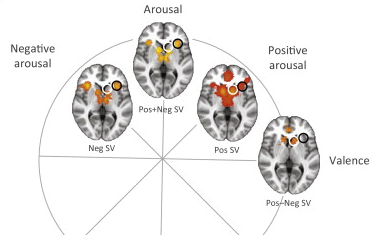Knutson et al. at Stanford note a correlation between self reported positive and negative arousal and fMRI measurement of brain activity in the nucleus accumbens and anterior insula (if you go to Google images and enter these terms you can see the locations of these regions in brain). Their abstract:
Neuroimaging findings are often interpreted in terms of affective experience, but researchers disagree about the advisability or even possibility of such inferences, and few frameworks explicitly link these levels of analysis. Here, we suggest that the spatial and temporal resolution of functional magnetic resonance imaging (fMRI) data could support inferences about affective states. Specifically, we propose that fMRI nucleus accumbens (NAcc) activity is associated with positive arousal, whereas a combination of anterior insula activity and NAcc activity is associated with negative arousal. This framework implies quantifiable and testable inferences about affect from fMRI data, which may ultimately inform predictions about approach and avoidance behavior.And a figure from their paper:

Meta-analytic results for activity in nucleus accumbens (NAcc; white circles) and anterior insula (black circles) during incentive anticipation. Activation likelihood estimate maps adapted from Bartra et al. - who also present a list of regions correlating with affect - superimposed onto the affective circumplex [from right to left: positive minus negative subjective value (SV), positive subjective value, positive plus negative subjective value, and negative subjective value]

